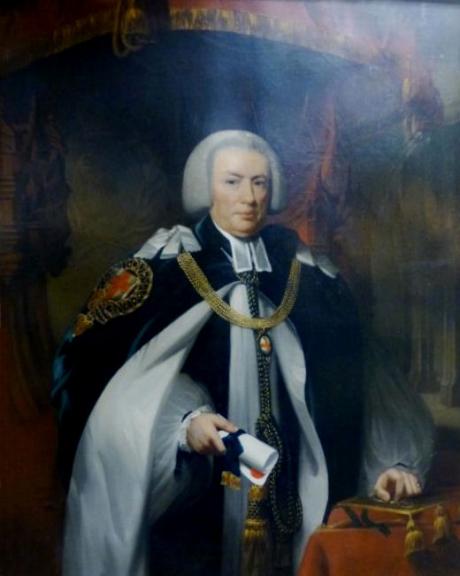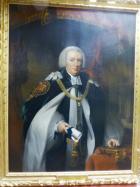inscribed on a plaque " Rt rev John Douglas, DD, Lord Bishop of Sarum, 1791"
By Direct Family descent
Douglas, John (1721–1807), bishop of Salisbury and writer, was born on 14 July 1721 in Pittenweem, Fife, the second son of Archibald Douglas, a merchant, and his wife, who was the daughter of Melvill of Carsender in Fife. His paternal grandfather was a distinguished minister in the Scottish Episcopal church, who, in 1669, had succeeded the historian Gilbert Burnet in the living of Saltoun, Haddingtonshire. Douglas attended the grammar school at Dunbar, where he received a good classical education, and was then sent for a short time to two private schools in London. In 1736 he was entered as a commoner at St Mary Hall, Oxford, and two years later he was elected to a Warner exhibition at Balliol College, where Adam Smith, a distant relative, was his contemporary. He graduated BA (1740) and MA (1743). He was sent abroad by his father, from 1740 to 1742, to learn French, and on taking deacon's orders in 1743 he embarked on a highly successful career as a clergyman. In July 1744 he became chaplain to the 3rd foot (Scots) guards, serving as an aide-de-camp at the battle of Fontenoy (29 April 1745). He resigned his commission on the army's return home the next year to fight the Jacobites, and was elected Snell exhibitioner at Balliol (1745–7).
Ordained priest in 1747, Douglas became curate of Tilehurst, near Reading, and also of Duns Tew, Oxfordshire. At about this time friends of his mother introduced him to William Pulteney, first earl of Bath, whose wealth and political and literary connections made him a highly desirable patron. An early assignment was to take Bath's ‘difficult’ heir, Lord Pulteney, on a grand tour of Holland, Germany, and France between July 1748 and October 1749. In Paris Douglas met Montesquieu but his journal of his tour devoted more pages to the Jansenist controversy and to the exposure of the miracles at deacon Pâris's tomb, which later figured in his pamphlet on supernatural phenomena, The Criterion. On his return to England he was presented by Lord Bath to the free chapel of Eaton Constantine and to the donative of Uppington in Shropshire, exchanging the latter, in 1750, for the vicarage of High Ercall, also in Shropshire. He seldom visited his livings but spent the winter in London, in a house next to that of his patron, whom he accompanied in the summer to Bath, Tunbridge Wells, and to nobles' houses, acting as Bath's chaplain and secretary. Douglas's first marriage, to Dorothy Pershore (d. 1752), sister of Richard Pershore of Reynolds Hall, Staffordshire, in September 1752, ended with her death in December of the same year. In April 1765 he married Elizabeth Rooke, daughter of Henry Brudenell Rooke. They had two children: William, who became chancellor of the diocese of Salisbury, and Elizabeth.
Douglas began to earn a reputation as a critic and controversialist, first by exposing the forgeries of William Lauder, who had accused Milton of plagiarism. His pamphlet on this subject, Milton No Plagiary, went into two editions (1750–51 and 1754), and caused Samuel Johnson, who had written a preface to Lauder's book, to dictate to Lauder a letter to Douglas, confessing to the imposture. Douglas then sought to elude David Hume's arguments against miracles in The Criterion (1752, 1754, and 1757), which made much of differences between alleged modern contraventions of the laws of nature and those presented in the Christian gospels. Later Douglas dined in a friendly spirit with Hume, who in 1773 considered him a ‘better hand’ than either Sir John Dalrymple or James Macpherson (Ossian) for continuing his History of England beyond 1689 (Letters, 2.269). After trouncing the Hutchesonian sect in an Apology for the Clergy (1755), Douglas then turned on the Scottish Jesuit mole Archibald Bower in several pamphlets published between 1756 and 1758, pillorying him for dishonesty and plagiarism.
Oxford University granted Douglas a DD in 1758, and Lord Bath presented him to the perpetual curacy of Kenley, Shropshire, also securing him a canonry at Windsor in 1762. The previous year Douglas had exchanged his Shropshire livings for the rectory of St Augustine with St Faith, Watling Street, London. He worked for Bath and his heir in Shropshire politics and wrote several political pamphlets, mainly under his patron's direction. He assisted Samuel Johnson in 1762 in the detection of the Cock Lane ghost. In the following year he edited the Diary and Letters of the second earl of Clarendon and accompanied his patron to Spa, where he made the acquaintance of the duke of Brunswick. Bath died on 1 July 1764, leaving his library to Douglas, who sold it for £1000 to Bath's brother and heir, General Henry Pulteney; on inheriting it a second time, on the latter's death, Douglas sold it again, on the same terms, to Sir William Pulteney so that it would remain at Bath House. He is believed to have been prevented from writing a biography of Lord Bath by General Pulteney's destruction of his brother's papers.
Douglas wrote more political articles, in 1766, 1767, and 1768, which were published by the Public Advertiser; he also contributed all the letters signed by Tacitus and by Manlius which appeared in that periodical in 1770 and 1771. In 1775–6, at the request of Lord Sandwich, he helped Captain James Cook to edit his journals (Voyage towards the South Pole, 1777); he also edited and wrote an influential introduction to Cook's last journals (Voyage to the Pacific Ocean, 1784). The second earl of Hardwicke enlisted him to edit hisMiscellaneous Papers, for publication in 1778, and the same year he was elected FRS and FSA. In March 1787 he was appointed a trustee of the British Museum, which had opened on 15 January 1759.
Throughout these years Douglas advanced steadily in his clerical career. In 1776 he exchanged his Windsor canonry for one at St Paul's; on 18 October 1787 he became bishop of Carlisle, on 21 March 1788 dean of Windsor, and on 28 July 1791 bishop of Salisbury. James Boswell obtained anecdotes and information from Douglas for his Life of Johnson and proposed him for membership of the Johnson Club on 14 December 1790; he was elected on 22 December 1792. Acknowledging his ‘advanced years and infirmities’ Douglas made a will, on 21 April 1806, which reflected his wealth, his fairness but not excessive charity to dependants, and his complete trust in his son William as executor. He died of a gradual decay on 18 May 1807, his wife having predeceased him. He was buried a week later, on 25 May, in St George's Chapel, Windsor.
Average for his time in the performance of clerical duties, Douglas was regarded as a likeable, sociable, and respectable figure in the Church of England. As a man of letters he was notably industrious, and his family rarely saw him without a pen or a book in his hand when company was absent. He was well read in history and literature as well as in the church fathers and English divines, and made a telling case in controversies within his knowledge. Of his writings his introduction to Cook's last explorations had perhaps the greatest impact, drawing wide European and American attention to the resources of the Pacific north-west.
Ian Simpson Ross DNB


